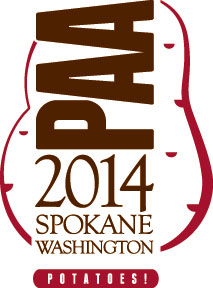2014 Call for Papers
The Call for Papers is now closed.
The Call for Papers is now closed.
This is the Second and Final Call for Papers to be presented at the 98th Annual Meeting of The Potato Association of America, to be held July 27 - 31, 2014 at the Davenport Hotel, Spokane, Washington, USA.
PAA members are invited to present papers dealing with all facets of the potato industry. A special grower-oriented session is planned for Tuesday. Applied research and extension-oriented submissions are encouraged for this session. Graduate students who are PAA members are encouraged to enter the Frank L. Haynes Graduate Student Research Competition.
Authors are required to submit abstracts for papers they wish to present, whether orally, as a poster, or in the Frank L. Haynes Graduate Student Research Competition. The abstracts for all papers (oral, poster and Graduate Student Research Competition) presented at the Annual Meeting will be published in a post-meeting issue of the American Journal of Potato Research. Abstracts of papers listed in the meeting program, but not presented, will not be published in the AJPR.
At the Annual Meeting, all oral paper presentations will be of a uniform 15-minute length. Authors should plan a 12- to 14-minute presentation with the balance of time devoted to questions. Computer projectors will be available for PowerPoint presentations. Please bring your PowerPoint presentation on a portable USB drive.
Display boards will be provided for posters. Dimensions will be 48”wide x 48” tall (122 cm wide x 122 cm high).
Abstracts will be accepted until Thursday, April 10, 2014. Submit abstracts as an e-mail attachment to cwohleb@wsu.edu with “PAA Abstract” as the e-mail subject. You will receive an email acknowledging receipt of the abstract. Abstracts submitted after that date will be returned to the author.
Abstract submission checklist (Maximum length of 2,000 characters. This size limit includes spaces):
1. Title
2. Author(s) and their affiliations - Presenter’s name underlined
3. Body of Abstract
4. PAA membership number of one (1) author
5. Presentation method (oral; oral graduate student; poster)
6. Section (breeding and genetics; plant protection; physiology; utilization and marketing; extension, production and management; certification)
Only the first 2,000 characters will be printed in the program- please keep your abstract, including title, authors and their affiliations, within the maximum allowable length.
Prior to submitting your abstract, please read and follow the formatting guidelines below.
Guidelines:
- Font: Times New Roman
- Font size: 12 pt
- Paragraph alignment: Left (do not select justified)
- Margins: 1 inch
- Title: Bold
- Length: Including title, authors, author affiliations and body, maximum of 2,000 characters, including spaces. Only the first 2,000 characters will be printed in the program.
- File type: Microsoft Word or WordPerfect document
Be sure to include:
- Type of presentation -- oral, poster or graduate student competition
- Section – Breeding; Plant Protection; Physiology; Extension, Production and Management; Utilization and Marketing; Certification.
- PAA Membership Number -- at least one (1) of the authors must be a PAA member
- Graduate Student Competition – graduate student presenting must be a PAA member to enter
- Person presenting the paper – underline the name of the presenting author
Your completed abstract should be formatted like this: (the following example contains 1995 characters)
________________________________________
Wound response is activated in tubers infected with zebra chip
Kumar, GNM and NR Knowles, Dept. of Horticulture, Washington State University, Pullman, WA 99164.
Zebra Chip (ZC) infected plants produce tubers that fail to sprout, exhibit brown discoloration of vascular tissue, and process into dark brown chips/fries. Rapid darkening of tissue slices from infected tubers suggests increased synthesis and/or oxidation of phenolic compounds, which are essential components of the polyphenolic (SPPD) and polyaliphatic domains (SPAD) of suberin. The effects of ZC on activities and transcript levels of key enzymes involved in wound response were investigated. Wound healed (3 days, 23oC, 99% RH) tissue discs from ZC-infected tubers developed greater resistance to desiccation stress than those from non-infected tubers, indicating more efficient wound healing. Tubers infected by ZC had substantially higher activities of starch phosphorylase, superoxide dismutase (SOD), peroxidase (POX), and polyphenol oxidase (PPO), and higher transcript levels for various enzymes [NADPH oxidase (NOX), POX, PPO, phenylalanine ammonia lyase (PAL), ketoacyl synthase (KCS), feruloyltransferase (FHT)] involved in the synthesis of aromatic and aliphatic monomers for SPPD and SPAD. Rapid dismutation of wound-induced superoxide radicals in infected tubers to H2O2 by SOD facilitates the POX-mediated incorporation of t-cinnamic acid (from PAL) into SPPD. In addition, increased expression of KCS, FHT and CYP (fatty acid acyl transferase) favors building the aliphatic domain of suberin. The increased ability of ZC-infected tubers to acquire resistance to desiccation during wound healing is therefore associated with enhanced capacity for suberin synthesis. ZC infection elicits responses in intact tubers similar to wounding and therefore infected tubers are primed for wound-healing. ZC infection offers the opportunity to better understand the mechanisms regulating suberization and wound healing. (Oral, Physiology, PAA Membership #526)
________________________________________
Questions? Problems? Please contact the PAA Secretary:
Carrie Huffman Wohleb
Washington State University Extension
PO Box 37
Ephrata, WA 98823 USA
Phone: 509-754-2011 x413
Fax: 509-754-0163
E-mail: cwohleb@wsu.edu



